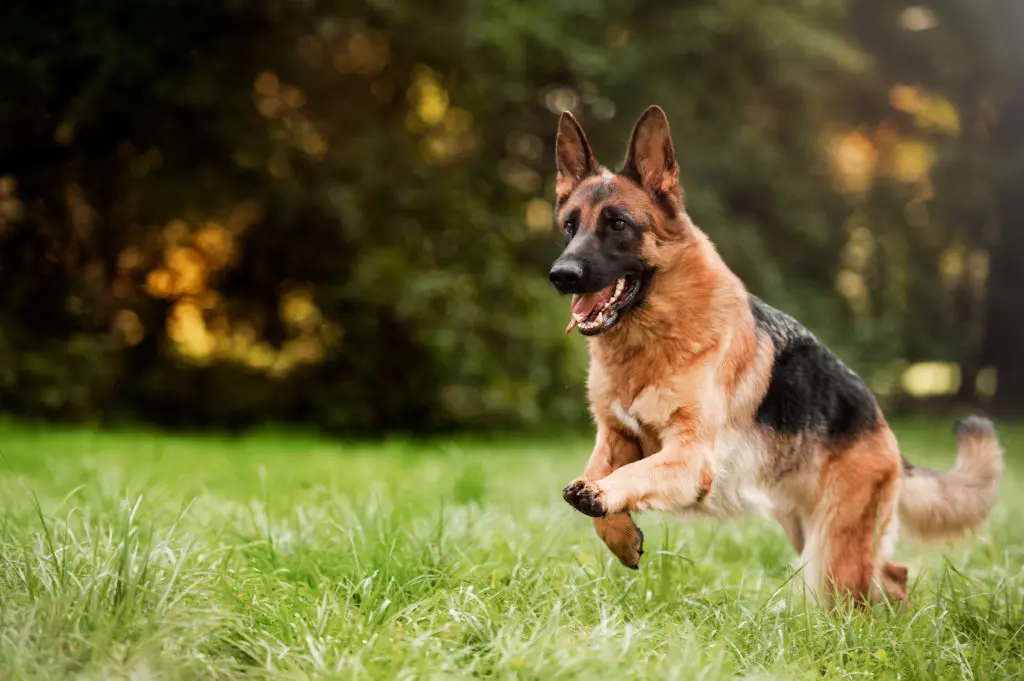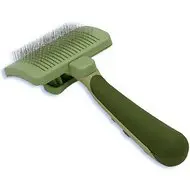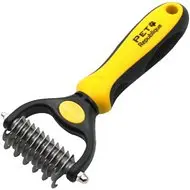5 Best Brushes for German Shepherds With 5 Simple Brushing Tips
Quick Guide
- What is the Best Brush for a German Shepherd?
- Different Types of Popular German Shepherd Brushes
- Understanding Your German Shepherd’s Coat
- Overall Best Brush for a German Shepherd
- 4 More Top-Rated German Shepherd Dog Brushes
- 5 Simple Tips to Brush a German Shepherd Properly
- FAQ Regarding German Shepherd Brushing/Grooming
Speed, strength, intelligence, and a sharp sense of smell were essential characteristics, but dog breeds were not standardized until the late 1800s. Regardless of when they got officially registered, many people can instantly recognize German shepherds. Not to mention, many canines of this breed have been famous.
German shepherds are friendly, intelligent, and easy to train. They make ideal police dogs, family pets, and even actors. Generally, they can have long, medium, or short coats. The undercoat is usually soft, thick, and fluffy. The outer coat is made of thicker, wiry fur that provides protection from harsh temperatures and wet weather.
Even if your German shepherd has a short coat, it will shed. Whereas some dog breeds shed only during certain seasons, the German shepherd sheds throughout the year. If you don’t keep up with grooming, you’ll have hair all over your house. Plus, your dog could develop mats and tangles that are uncomfortable and trap dirt.
If you don’t groom your German shepherd, it could develop hot spots or rashes. You should rake your shepherd’s coat regularly and brush it daily. You will need more than one grooming tool to care for your pooch properly. German shepherds with short or medium coats usually require two or three grooming tools, including an undercoat rake and a standard brush. A grooming glove can also remove loose hair from the outer layers.
Long-coat German shepherds require about three or four tools. You should use a basic brush, an undercoat rake, a grooming mitt, and a slicker brush. There are some other tools that can come in handy for keeping your German shepherd healthy and dapper. We will go over those in this article and give you tips for using each one!
What is the Best Brush for a German Shepherd?
Different Types of Popular German Shepherd Brushes
You need a few tools to groom your German shepherd. Different brushes have distinct purposes. The following brushes are popular for taking care of German shepherds.
Basic Brushes
If you have nothing else, you’ll need a basic brush to care for your German shepherd. These usually have metal or plastic bristles. They may be two-sided, with the different types of bristles on either face of the brush.
Wire bristles are excellent for extending into the dog’s undercoat. They remove the fluff that gets stuck in the inner layer. Some people call wire-bristle brushes pin brushes.
Brushes with plastic bristles remove the guard hairs on the outside of the canine’s coat. The softer plastic bristles also remove dirt and debris.
Use this type of brush every day. Grooming your dog daily will keep it healthy, clean, and tangle-free.
Slicker Brushes
Slicker brushes are made for dogs with long hair. These usually have a flat head with metal bristles. The bristles are not as thick as those on a basic brush. They reach deep into the fur and massage the skin while you’re using them.
A slicker brush removes hair from the undercoat as well as the exterior layer. It also gets rid of dust and dirt. Some slicker brushes are self-cleaning. After you brush your dog, press a button on the brush to drop the fur into the garbage.
Undercoat Rakes
Don’t confuse an undercoat rake with a slicker brush. Undercoat rakes look like slicker brushes, but they have fewer pins. The bristles are also longer than those on a slicker brush.
This grooming tool removes hair from the undercoat. It penetrates even the thickest fur and is ideal to use when your dog is shedding profusely. Sometimes, these brushes are called de-shedding tools.
Combs
Pet combs come in several different styles. Some are designed to detangle long hair without pulling on it and hurting your pooch. Others aren’t meant to detangle, but they leave your dog’s fur lying flat and smooth in one direction.
Steel combs stimulate your pooch’s hair follicles, helping them grow healthy fur. They also distribute oils through your dog’s coat to keep it shiny.
Shedding Blades
A shedding blade sounds dangerous, but it’s not. It usually has a handle with a teardrop-shaped band of flexible metal extending from it. The metal piece has teeth on one or both edges. You can drag a shedding blade across your dog’s coat to remove loose hair. This is a quick and easy way to prevent shedding hair from building up in your house.
Understanding Your German Shepherd’s Coat
Most German shepherds have a double coat. The outer layer of fur is referred to as a top coat or guard coat. Although this hair is soft, it’s coarser and scratchier than the underlayer. It’s also darker.
Experts call the underlayer the undercoat. It’s soft and lighter in color than the guard coat.
The two layers of fur work together to help the dog maintain its body temperature. The combination of coat types protects the dog from water and harmful UV rays.
Some German shepherds have a single coat. These look smoother and less fluffy than double-coated canines. Some people call single-coat breeds “smoothies.” These canines do have an undercoat, but it’s so fine that it’s almost imperceptible.
Because a single coat is considered a flaw, most experts have tried to breed out that trait. Therefore, single-coat German shepherds are rare.
You might wonder why you see German shepherds with different coat lengths. Working German shepherds often have short or medium coats. Their fur won’t hinder their activity while they’re performing their service.
German shepherds with medium coats have fur that’s about one to two inches long. Some people call these dogs “plush.” Medium-length coats are the most desirable by American Kennel Club standards.
“German shedders” is one nickname for these pooches. They lose copious amounts of hair throughout the year. They also blow their coats in the fall and spring. This means that they shed heavily during this time.
In the spring, the dog sheds the undercoat and grows a thinner inner layer of fur to withstand the heat of the summer. In the fall, the German shepherd loses the warm-weather undercoat and gains a new, thick underlayer to stay warm in the winter.
Overall Best Brush for a German Shepherd
| Our 2025 Picks: Best Brush for German Shepherds | |||
Safari Self-Cleaning Slicker Brush for Dogs
|
CHECK PRICE | ||
FURminator deShedding Edge Dog Brush
|
CHECK PRICE | ||
Pet Republique Dematting Rake
|
CHECK PRICE | ||
ConairPRO Pet-It Dog Metal Pin Brush
|
CHECK PRICE | ||
 |
Hartz Groomer’s Best Combo Dog Brush
|
CHECK PRICE | |
We’ve narrowed it down to our favorite option below:
Safari Self-Cleaning Slicker Brush for Dogs
Although you should use a few different brushes for your German shepherd, if you had to buy one, it could be this one. This slicker brush is gentle but reaches deep into the dog’s coat. The pins are inserted in such a way that they glide through your pup’s fur without pulling or pinching. Combined with a comfort-grip handle, the smooth-glide pins make brushing your dog quick and efficient.
Plus, cleaning this brush is a breeze. When you press a button, the pins retract into the head of the brush, leaving behind the hairs to discard.
This brush is ideal for tackling a German shepherd’s undercoat. If you use a light touch, you can also use the brush to groom the outer layer of fur.
4 More Top-Rated German Shepherd Dog Brushes
If the one above doesn’t catch your eye, maybe one of these will:
FURminator deShedding Edge Dog Brush
You might be surprised that this de-shedding brush can get through your German shepherd’s thick fur. But this tool comes in a version for long hair as well as short hair.
The long-haired version is probably the best for a medium or long coat. The tool reaches through the outer layer of hair to remove fur from the underlayer. It doesn’t damage the guard coat or the dog’s skin.
Plus, it’s comfortable for both you and your pooch. The handle is ergonomic and easy to hold without losing your grip. The edge of the brush is curved to glide over your dog’s body.
The manufacturer claims that this tool can reduce loose, shedding hair by up to 90 percent.
Pet Republique Dematting Rake
This de-matting rake looks like it might be uncomfortable. However, it’s one way to keep your dog well-groomed without harming its sensitive skin. The blades have rounded edges, and they won’t snag hair or scratch your pup’s skin.
The tool has stainless-steel teeth, which break through tough mats without pulling on your pet’s coat. One side of the blade has 12 teeth and is made for coarse fur. The other side has 23 blades and is created for thinner coats.
The non-slip handle enhances your mobility and makes it easy to hold onto the brush. You can access hard-to-reach spots with this tool. Plus, it’s easy to clean.
ConairPRO Pet-It Dog Metal Pin Brush
This metal pin brush has flexible bristles and unique design. Many pin brushes have a handle that extends from the head. This one has a shorter handle on top and fits into the palm of your hand. It mimics the movement that you make when you pet your dog, and it might be easier to use long strokes with this brush than one with a longer handle.
Therefore, this brush may be ideal for dogs that hate being groomed. It’s easy to pull your small dog into your lap for grooming, offering plenty of snuggles at the same time.
The stainless steel pins resist rust and corrosion. Moreover, they’re coated with comfort tips so that they feel good against your Frenchie’s skin. The smooth bristles slip through knots, detangling them without hurting your pooch.
Hartz Groomer’s Best Combo Dog Brush
You’ll need a basic brush for everyday grooming. This one has pins on one side and bristles on the other, giving you a little more bang for your buck. This brush has a variety of purposes. It removes loose fur, detangles, and smooths. It also gets rid of dirt that might be hidden in your dog’s coat.
The metal pins have safety tips and are gentle against your dog’s skin. The nylon bristles spread natural oils from your pup’s skin throughout its fur.
Even though this brush is soft and gentle, it gets through wiry fur. That makes it excellent for dealing with a fluffy German shepherd’s coat.
5 Simple Tips to Brush a German Shepherd Properly
A German shepherd’s coat requires some maintenance. Here are some simple tips for brushing your German shepherd.
- Look out for mats – One of the reasons that you should brush your dog is to prevent matting. Tangles can pull at your dog’s skin, causing pain with every movement. Daily brushing should keep your dog tangle-free.
- Remove mats first – You won’t be able to brush your dog’s fur properly unless you get rid of mats and tangles. Use a de-matting rake or brush first to break up knots.
- Consider asking for help – It might help if you have a friend or family member help you groom your German shepherd. One person can pet the dog’s ears, head, and neck while the other brushes its body.
- Don’t let your dog play with the grooming tools – To keep your brushing sessions peaceful and relaxing, make sure that your dog doesn’t think that the brushes are toys. Only bring them out during grooming time, and don’t allow your dog to bite or paw at them.
- Smooth the loose fur last – Use a bristle, pin, or slicker brush last to remove remaining loose hairs from the outer layer of your dog’s coat. This will leave all the hairs in the same direction and make your pup look smooth and shiny.
Remember to make grooming an enjoyable experience by staying calm and offering plenty of treats. Brushing can be an essential bonding experience for you and your pooch.
FAQ Regarding German Shepherd Brushing/Grooming
If you still have questions about brushing or grooming your German shepherd, read on to see if we have the answers.
Should you shave a German Shepherd?
Although a German shepherd might seem hot in the summer with all that fur, they shouldn’t be shaved. Their undercoat works with the guard coat to regulate body temperature, retain moisture, and protect your pooch’s skin. Without fur, your pup may get sunburned or scratched.
Do you really need to brush your dog every day?
Brushing a German shepherd daily is one of the best ways to maintain its healthy coat. If you can’t brush every day, make sure that you groom your dog at least three or four times a week. You’ll need to brush your shepherd at least once a day during shedding season.
Should you bathe a German shepherd?
Bathing a German shepherd can remove up to 20 percent more shedding hair. Consider using a de-shedding shampoo and brushing your pooch’s coat while it’s still wet, immediately after the bath. But bathing too often can leave your pup’s skin dry and irritated. You only need to bathe a German shepherd every eight weeks or so.
















